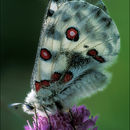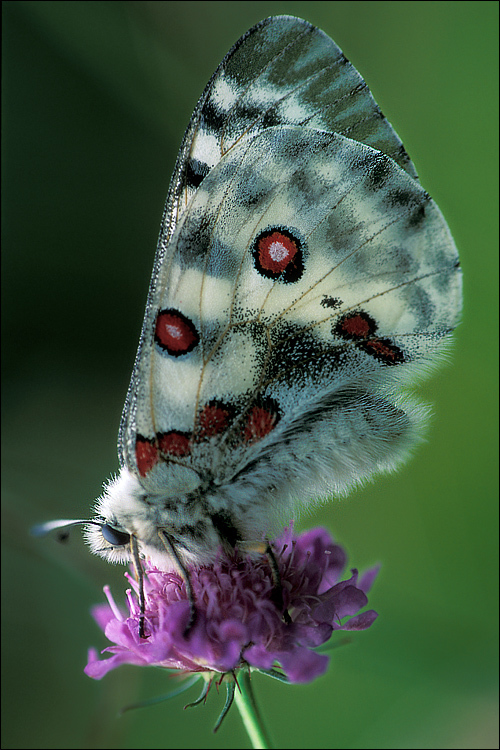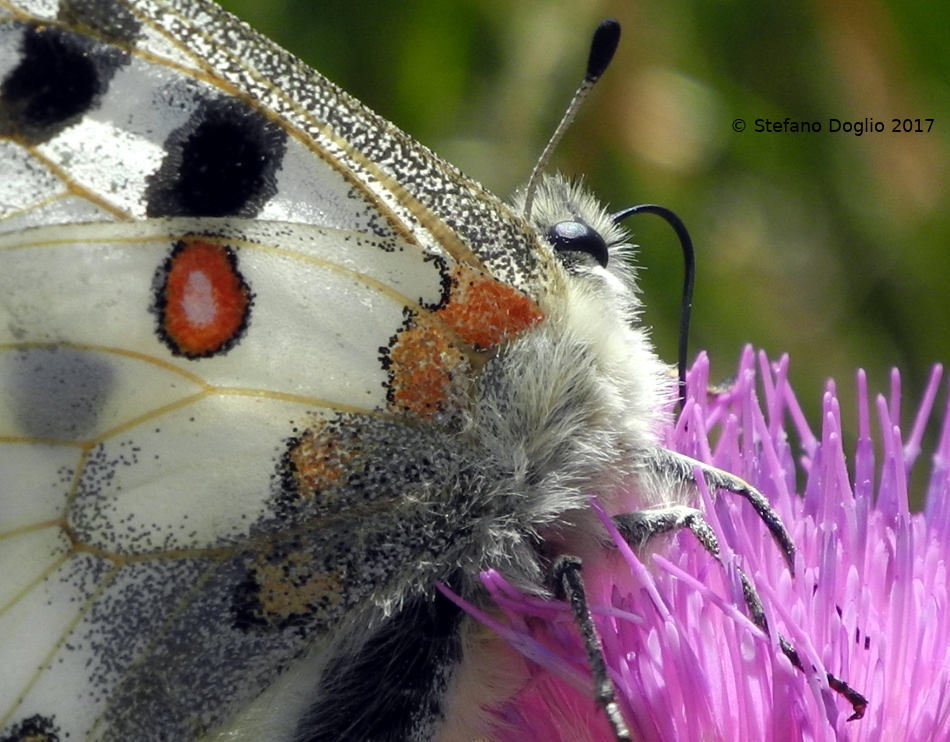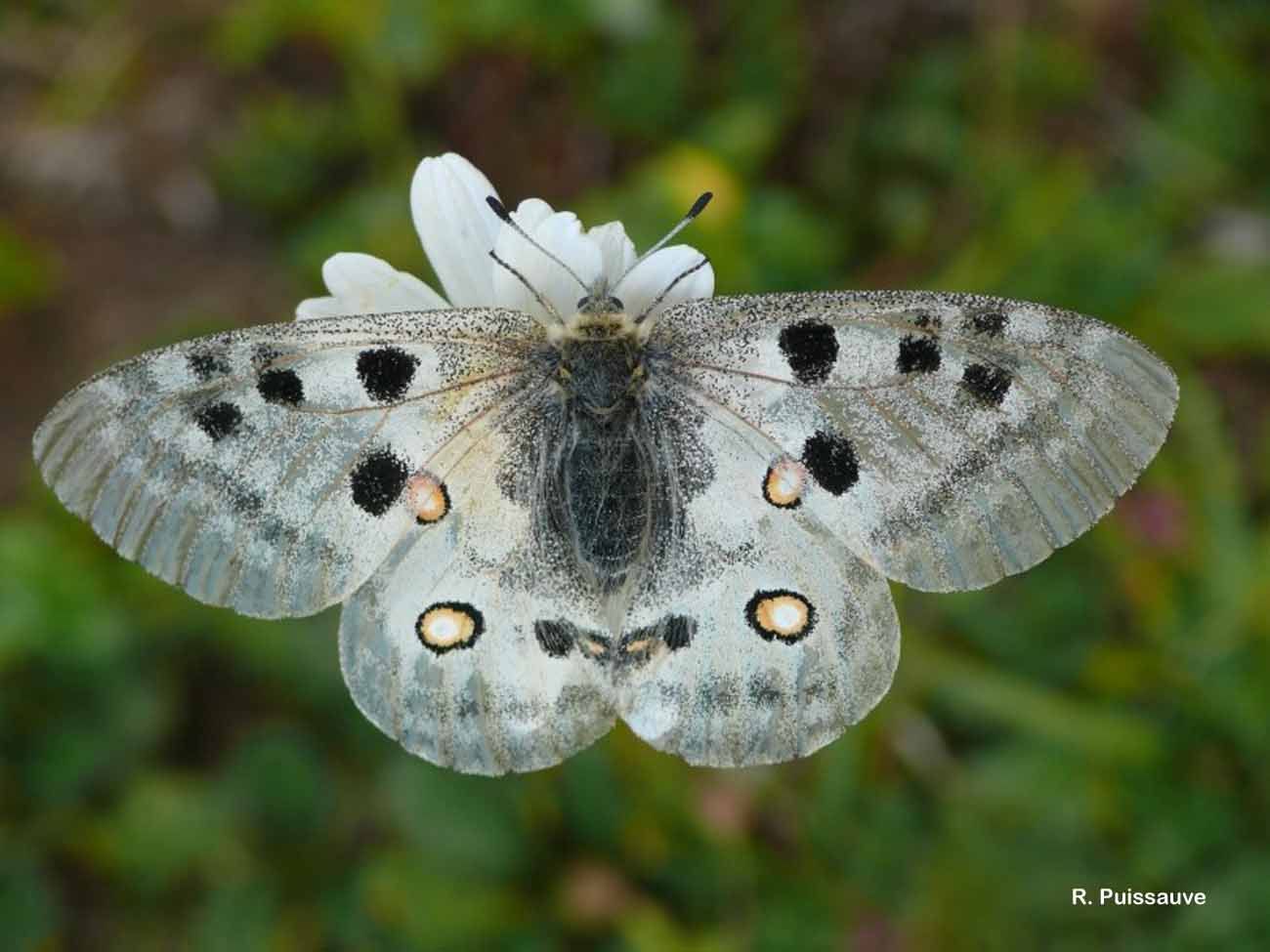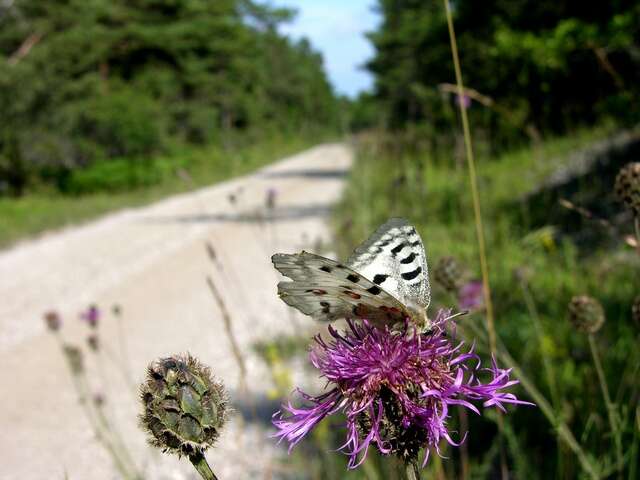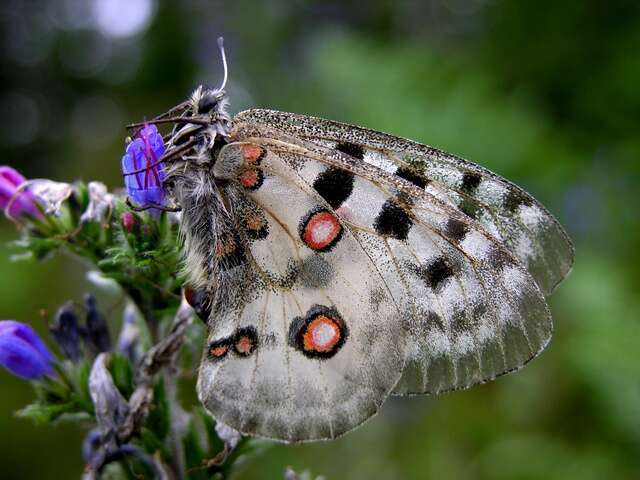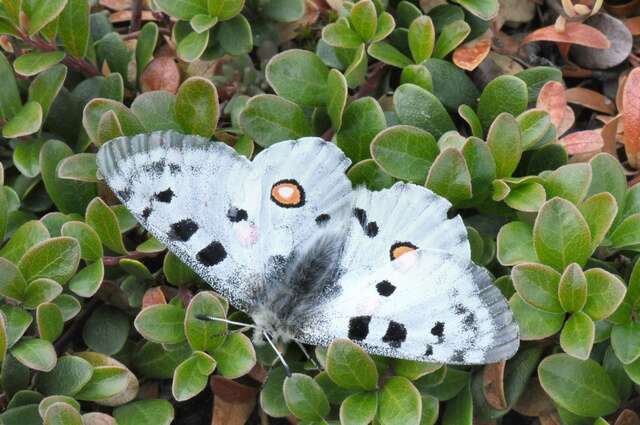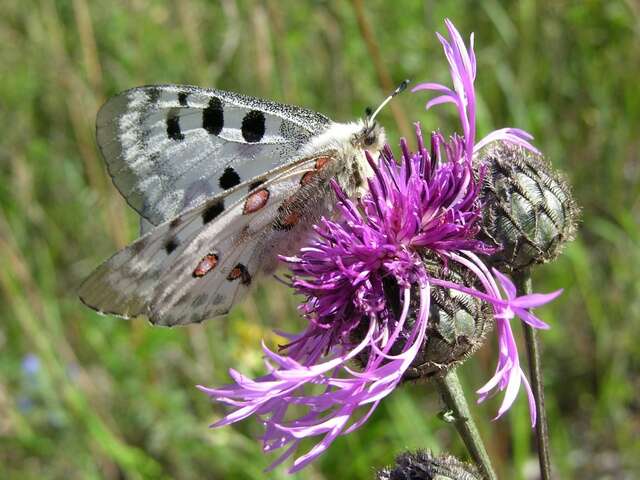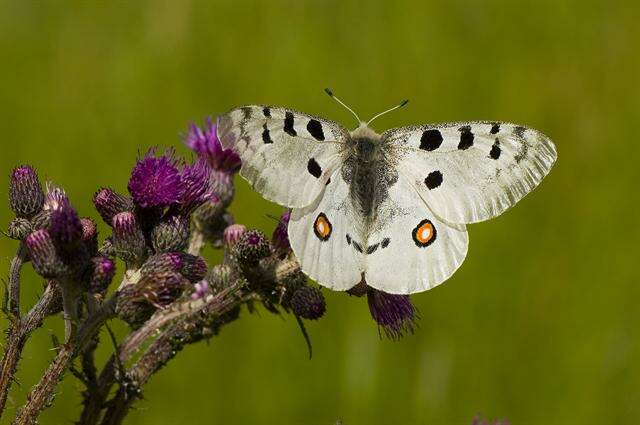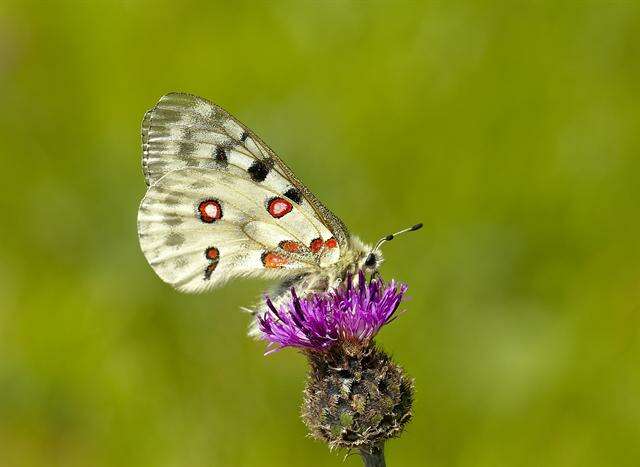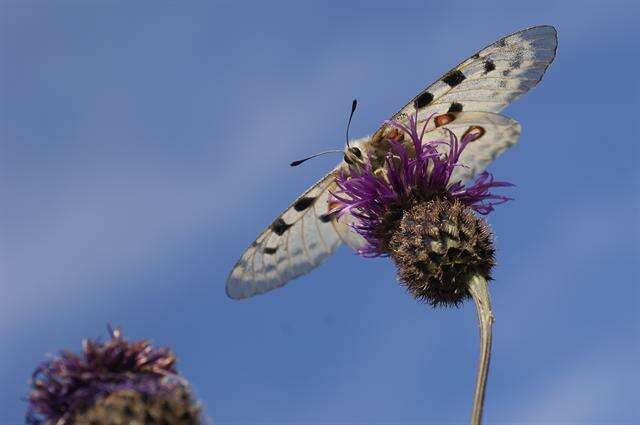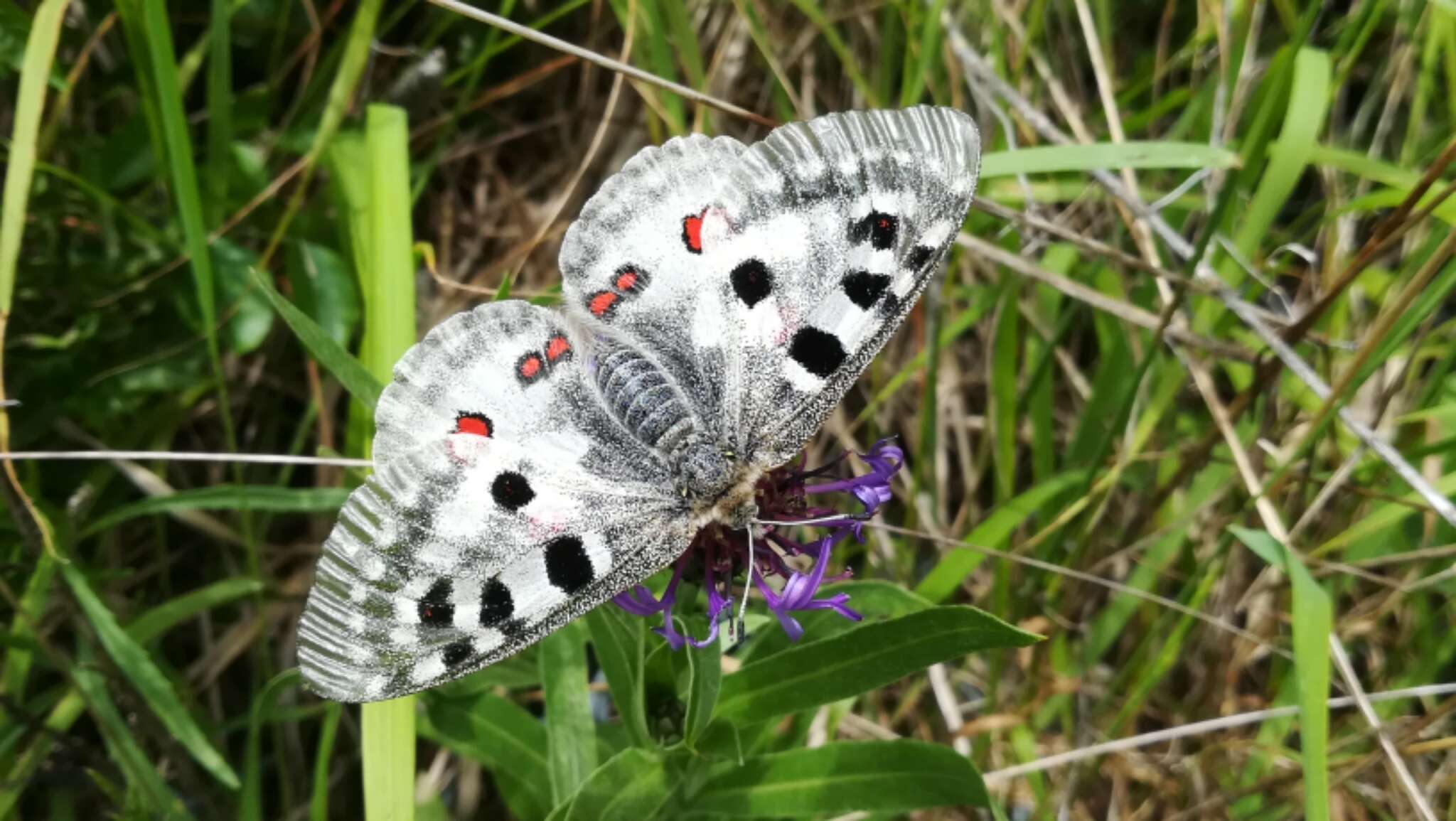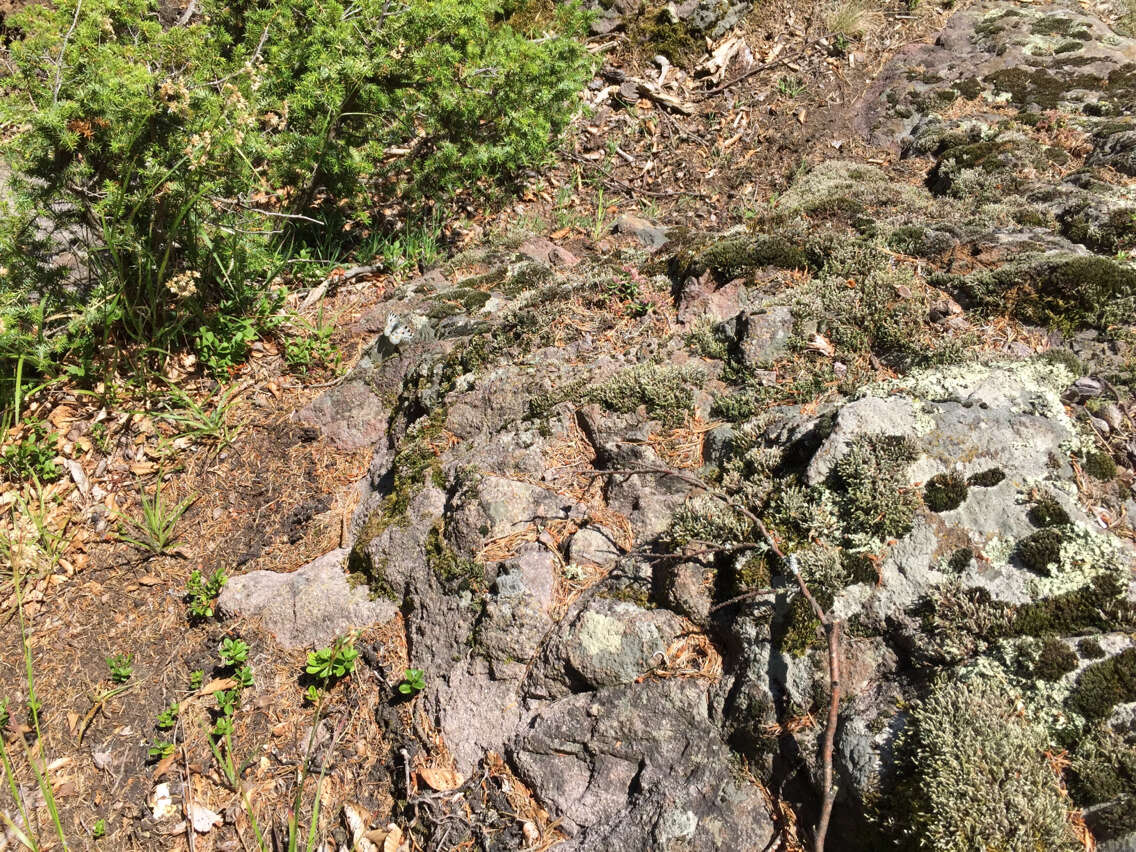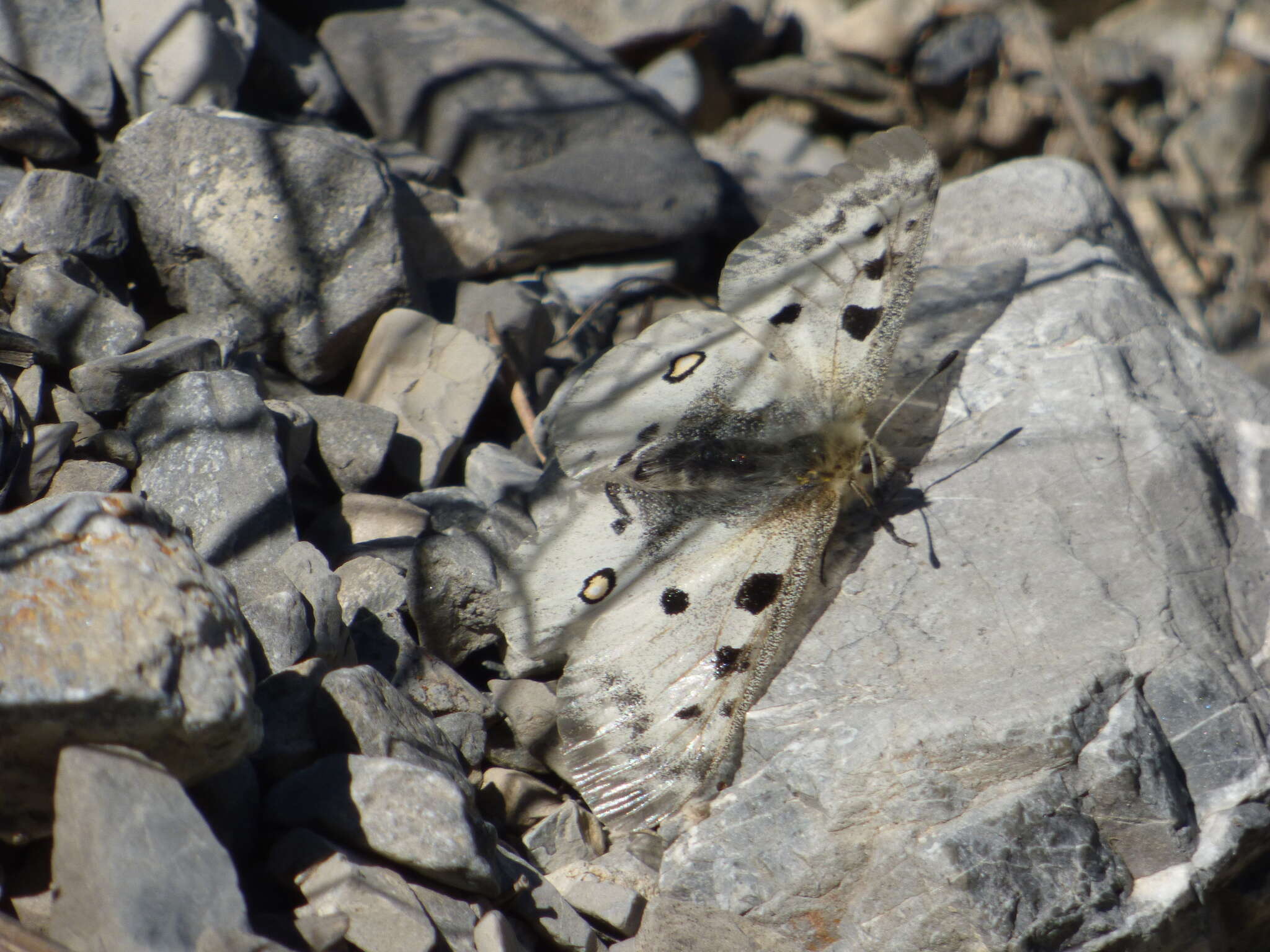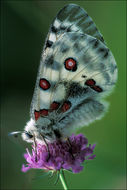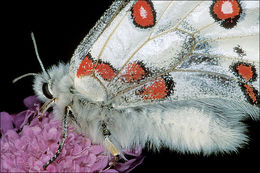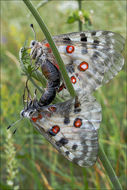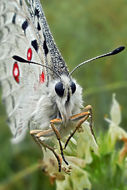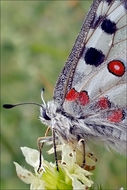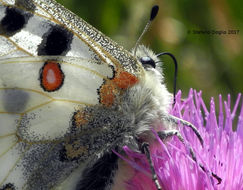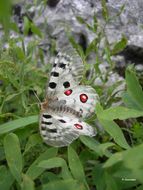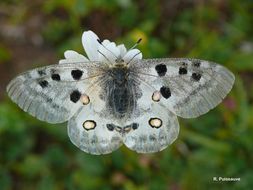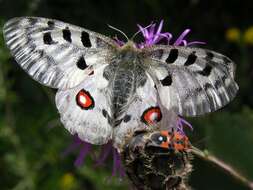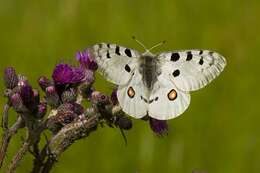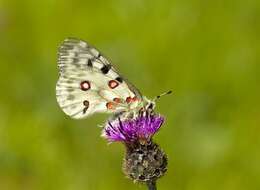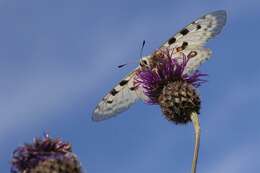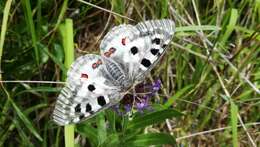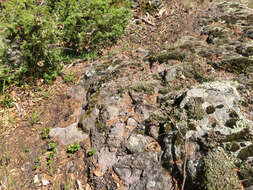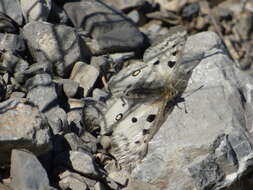-
Slo.: apolon
-
Slo.: apolon
-
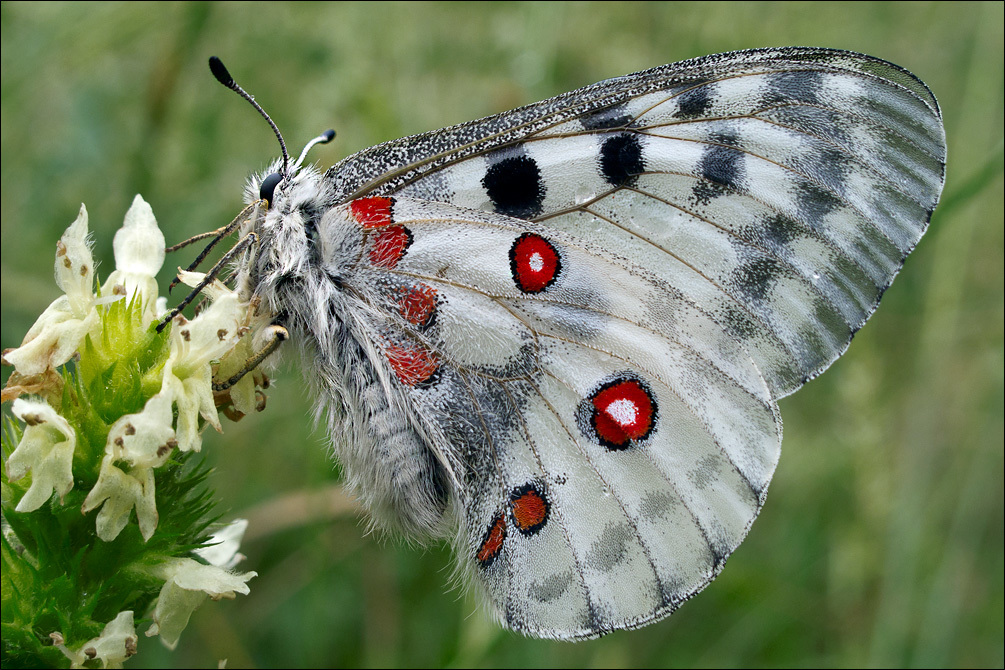
Slo.: gorski apolon, rdei apolon - Habitat: Mountain pasture, moderately southeast inclined; calcareous ground, dry and sunny place, exposed to direct rain, average precipitations ~ 3.000 mm/year, average temperature 7-9 deg C, elevation 620 m (2.050 feet), alpine phytogeographical region. - Comment: Parnassius apollo is one of the largest and most beautiful butterflies in Europe. Linne himself has named it after the god of light, art and beauty Apollo. No wander it has been extensively collected and traded by butterfly collectors and 'lovers'. This is considered as the most important reason that the species is in sharp decline. This Alpine meadows and warm mountain slopes dweller is protected by law in most European countries, in Slovenia it is one of the first protected species at all (in 1920). - The butterfly is using its bright red spots to frighten potential enemies. Normally the spots are not visible from above when it sits on ground or flowers. But when disturbed, it abruptly stretches its forewing so that bright red 'dangerously looking eyes' on hind wings appear (compare pictures 5 and 6). Another amazing feature of this butterfly is called sphragus. This is a structure that is attached to the female's abdomen by the male during mating, which physically prevents the female mating a second time. Parnassius apollo caterpillars feed exclusively on stonecrop (Sedum sp./mostly Sedum album in Trenta valley) and houseleek (Sempervivum sp.). - Parnassius apollo is classified as Vulnerable (VU) on the IUCN Red List, and listed on Appendix II of Convention on International Trade in Endangered Species(CITES). In Slovenia it is enlisted in the Slovene Red List of rare and endangered species, marked by 'V' representing a vulnerable species. - Ref.: (1) http://www.eurobutterflies.com/sp/apollo.php (2) http://www.arkive.org/apollo-butterfly/parnassius-apollo/ (3) Fauna Europas, Bestimmungs lexikon, George Westermann Velag, Braunschweig (1997), (translated to Slovenian), Mladinska Knjiga, Ljubljana (1981).
-
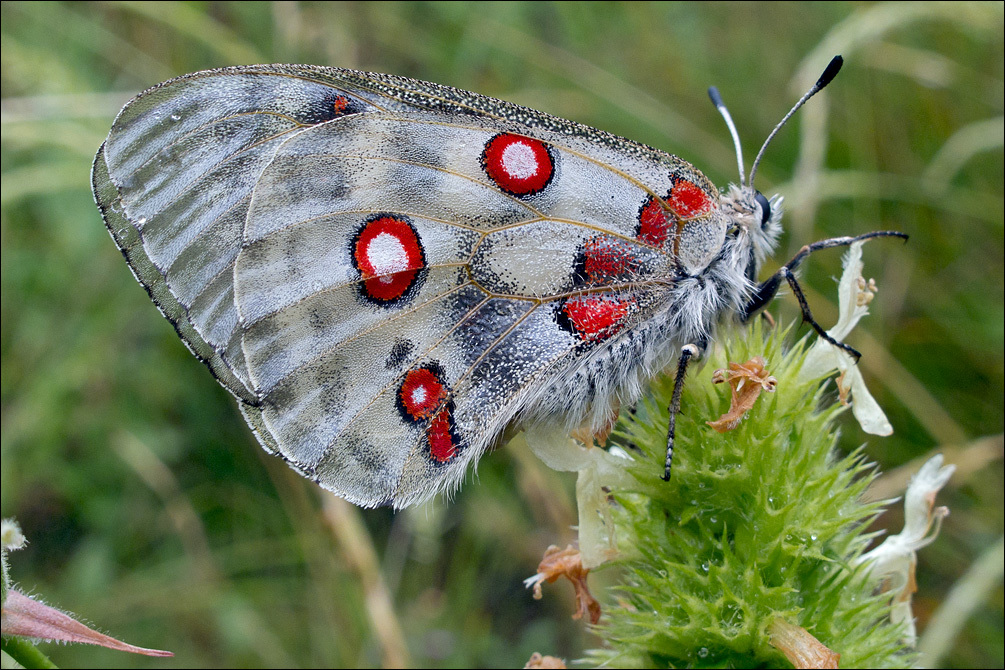
Slo.: gorski apolon, rdei apolon - Habitat: Mountain pasture, moderately southeast inclined; calcareous ground, dry and sunny place, exposed to direct rain, average precipitations ~ 3.000 mm/year, average temperature 7-9 deg C, elevation 620 m (2.050 feet), alpine phytogeographical region. - Comment: Parnassius apollo is one of the largest and most beautiful butterflies in Europe. Linne himself has named it after the god of light, art and beauty Apollo. No wander it has been extensively collected and traded by butterfly collectors and 'lovers'. This is considered as the most important reason that the species is in sharp decline. This Alpine meadows and warm mountain slopes dweller is protected by law in most European countries, in Slovenia it is one of the first protected species at all (in 1920). - The butterfly is using its bright red spots to frighten potential enemies. Normally the spots are not visible from above when it sits on ground or flowers. But when disturbed, it abruptly stretches its forewing so that bright red 'dangerously looking eyes' on hind wings appear (compare pictures 5 and 6). Another amazing feature of this butterfly is called sphragus. This is a structure that is attached to the female's abdomen by the male during mating, which physically prevents the female mating a second time. Parnassius apollo caterpillars feed exclusively on stonecrop (Sedum sp./mostly Sedum album in Trenta valley) and houseleek (Sempervivum sp.). - Parnassius apollo is classified as Vulnerable (VU) on the IUCN Red List, and listed on Appendix II of Convention on International Trade in Endangered Species(CITES). In Slovenia it is enlisted in the Slovene Red List of rare and endangered species, marked by 'V' representing a vulnerable species. - Ref.: (1) http://www.eurobutterflies.com/sp/apollo.php (2) http://www.arkive.org/apollo-butterfly/parnassius-apollo/ (3) Fauna Europas, Bestimmungs lexikon, George Westermann Velag, Braunschweig (1997), (translated to Slovenian), Mladinska Knjiga, Ljubljana (1981).
-
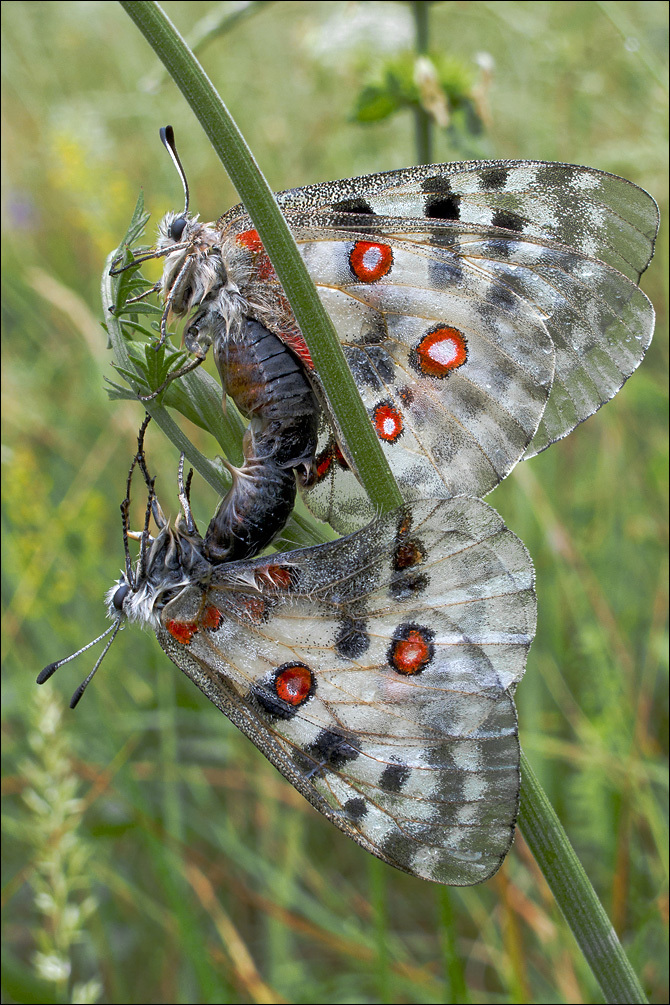
Slo.: gorski apolon, rdei apolon - Habitat: Mountain pasture, moderately southeast inclined; calcareous ground, dry and sunny place, exposed to direct rain, average precipitations ~ 3.000 mm/year, average temperature 7-9 deg C, elevation 620 m (2.050 feet), alpine phytogeographical region. - Comment: Parnassius apollo is one of the largest and most beautiful butterflies in Europe. Linne himself has named it after the god of light, art and beauty Apollo. No wander it has been extensively collected and traded by butterfly collectors and 'lovers'. This is considered as the most important reason that the species is in sharp decline. This Alpine meadows and warm mountain slopes dweller is protected by law in most European countries, in Slovenia it is one of the first protected species at all (in 1920). - The butterfly is using its bright red spots to frighten potential enemies. Normally the spots are not visible from above when it sits on ground or flowers. But when disturbed, it abruptly stretches its forewing so that bright red 'dangerously looking eyes' on hind wings appear (compare pictures 5 and 6). Another amazing feature of this butterfly is called sphragus. This is a structure that is attached to the female's abdomen by the male during mating, which physically prevents the female mating a second time. Parnassius apollo caterpillars feed exclusively on stonecrop (Sedum sp./mostly Sedum album in Trenta valley) and houseleek (Sempervivum sp.). - Parnassius apollo is classified as Vulnerable (VU) on the IUCN Red List, and listed on Appendix II of Convention on International Trade in Endangered Species(CITES). In Slovenia it is enlisted in the Slovene Red List of rare and endangered species, marked by 'V' representing a vulnerable species. - Ref.: (1) http://www.eurobutterflies.com/sp/apollo.php (2) http://www.arkive.org/apollo-butterfly/parnassius-apollo/ (3) Fauna Europas, Bestimmungs lexikon, George Westermann Velag, Braunschweig (1997), (translated to Slovenian), Mladinska Knjiga, Ljubljana (1981).
-
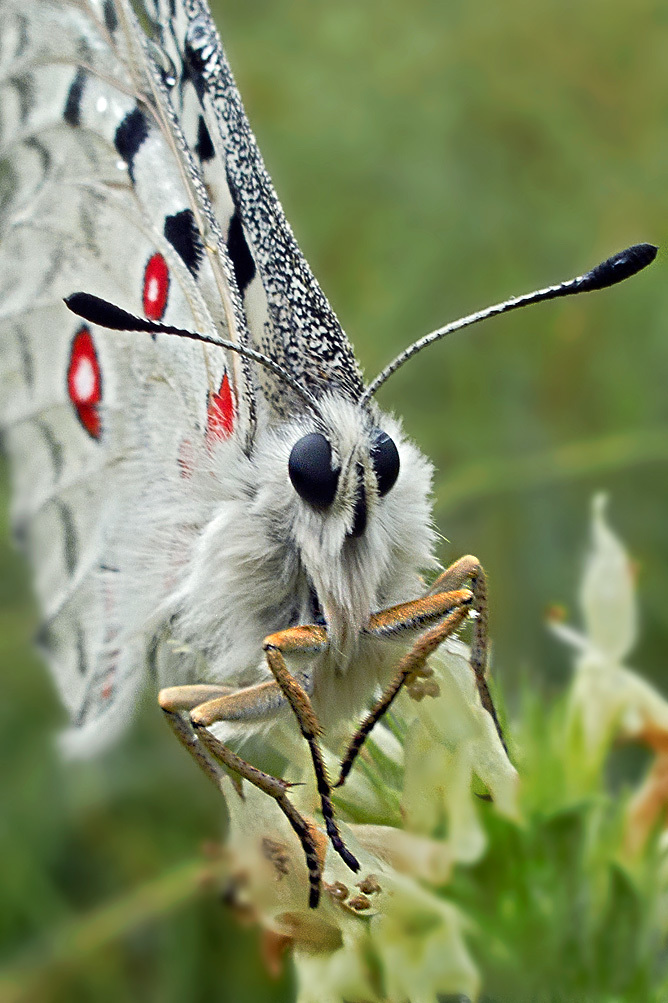
Slo.: gorski apolon, rdei apolon - Habitat: Mountain pasture, moderately southeast inclined; calcareous ground, dry and sunny place, exposed to direct rain, average precipitations ~ 3.000 mm/year, average temperature 7-9 deg C, elevation 620 m (2.050 feet), alpine phytogeographical region. - Comment: Parnassius apollo is one of the largest and most beautiful butterflies in Europe. Linne himself has named it after the god of light, art and beauty Apollo. No wander it has been extensively collected and traded by butterfly collectors and 'lovers'. This is considered as the most important reason that the species is in sharp decline. This Alpine meadows and warm mountain slopes dweller is protected by law in most European countries, in Slovenia it is one of the first protected species at all (in 1920). - The butterfly is using its bright red spots to frighten potential enemies. Normally the spots are not visible from above when it sits on ground or flowers. But when disturbed, it abruptly stretches its forewing so that bright red 'dangerously looking eyes' on hind wings appear (compare pictures 5 and 6). Another amazing feature of this butterfly is called sphragus. This is a structure that is attached to the female's abdomen by the male during mating, which physically prevents the female mating a second time. Parnassius apollo caterpillars feed exclusively on stonecrop (Sedum sp./mostly Sedum album in Trenta valley) and houseleek (Sempervivum sp.). - Parnassius apollo is classified as Vulnerable (VU) on the IUCN Red List, and listed on Appendix II of Convention on International Trade in Endangered Species(CITES). In Slovenia it is enlisted in the Slovene Red List of rare and endangered species, marked by 'V' representing a vulnerable species. - Ref.: (1) http://www.eurobutterflies.com/sp/apollo.php (2) http://www.arkive.org/apollo-butterfly/parnassius-apollo/ (3) Fauna Europas, Bestimmungs lexikon, George Westermann Velag, Braunschweig (1997), (translated to Slovenian), Mladinska Knjiga, Ljubljana (1981).
-
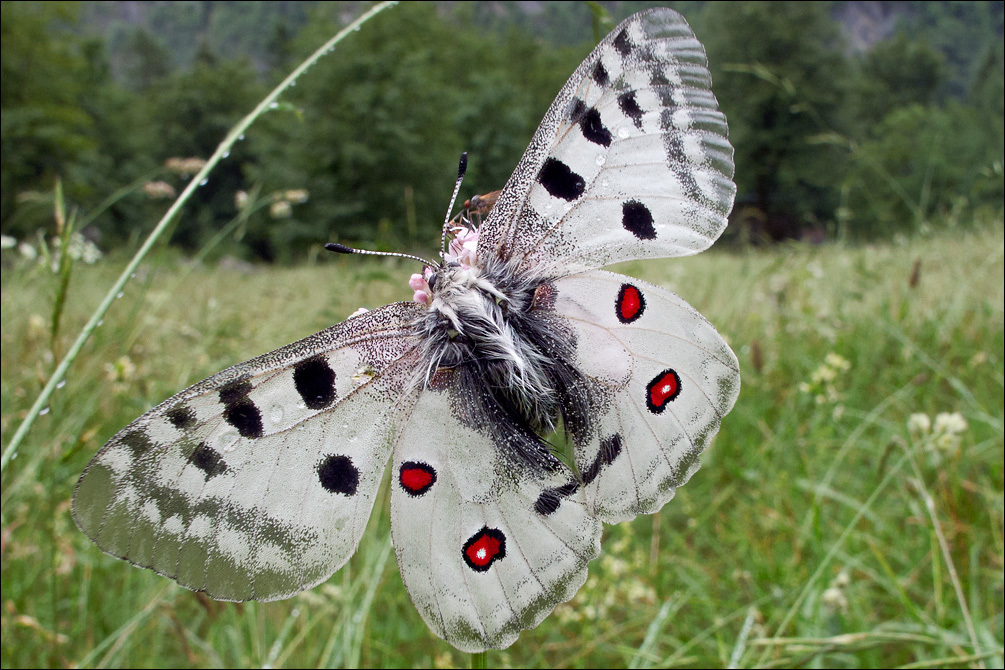
Slo.: gorski apolon, rdei apolon - Habitat: Mountain pasture, moderately southeast inclined; calcareous ground, dry and sunny place, exposed to direct rain, average precipitations ~ 3.000 mm/year, average temperature 7-9 deg C, elevation 620 m (2.050 feet), alpine phytogeographical region. - Comment: Parnassius apollo is one of the largest and most beautiful butterflies in Europe. Linne himself has named it after the god of light, art and beauty Apollo. No wander it has been extensively collected and traded by butterfly collectors and 'lovers'. This is considered as the most important reason that the species is in sharp decline. This Alpine meadows and warm mountain slopes dweller is protected by law in most European countries, in Slovenia it is one of the first protected species at all (in 1920). - The butterfly is using its bright red spots to frighten potential enemies. Normally the spots are not visible from above when it sits on ground or flowers. But when disturbed, it abruptly stretches its forewing so that bright red 'dangerously looking eyes' on hind wings appear (compare pictures 5 and 6). Another amazing feature of this butterfly is called sphragus. This is a structure that is attached to the female's abdomen by the male during mating, which physically prevents the female mating a second time. Parnassius apollo caterpillars feed exclusively on stonecrop (Sedum sp./mostly Sedum album in Trenta valley) and houseleek (Sempervivum sp.). - Parnassius apollo is classified as Vulnerable (VU) on the IUCN Red List, and listed on Appendix II of Convention on International Trade in Endangered Species(CITES). In Slovenia it is enlisted in the Slovene Red List of rare and endangered species, marked by 'V' representing a vulnerable species. - Ref.: (1) http://www.eurobutterflies.com/sp/apollo.php (2) http://www.arkive.org/apollo-butterfly/parnassius-apollo/ (3) Fauna Europas, Bestimmungs lexikon, George Westermann Velag, Braunschweig (1997), (translated to Slovenian), Mladinska Knjiga, Ljubljana (1981).
-
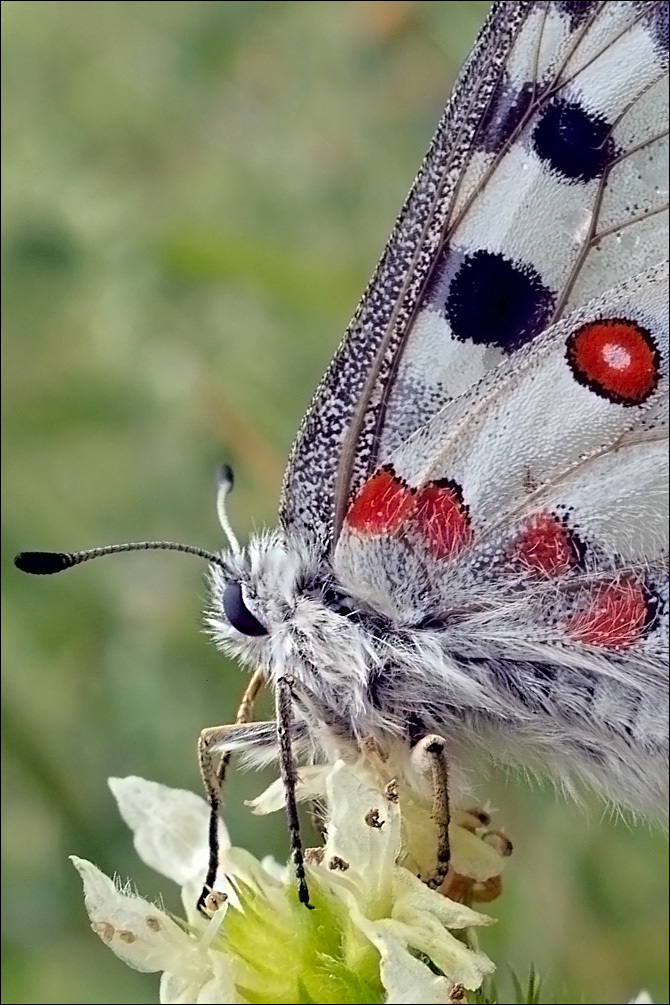
Slo.: gorski apolon, rdei apolon - Habitat: Mountain pasture, moderately southeast inclined; calcareous ground, dry and sunny place, exposed to direct rain, average precipitations ~ 3.000 mm/year, average temperature 7-9 deg C, elevation 620 m (2.050 feet), alpine phytogeographical region. - Comment: Parnassius apollo is one of the largest and most beautiful butterflies in Europe. Linne himself has named it after the god of light, art and beauty Apollo. No wander it has been extensively collected and traded by butterfly collectors and 'lovers'. This is considered as the most important reason that the species is in sharp decline. This Alpine meadows and warm mountain slopes dweller is protected by law in most European countries, in Slovenia it is one of the first protected species at all (in 1920). - The butterfly is using its bright red spots to frighten potential enemies. Normally the spots are not visible from above when it sits on ground or flowers. But when disturbed, it abruptly stretches its forewing so that bright red 'dangerously looking eyes' on hind wings appear (compare pictures 5 and 6). Another amazing feature of this butterfly is called sphragus. This is a structure that is attached to the female's abdomen by the male during mating, which physically prevents the female mating a second time. Parnassius apollo caterpillars feed exclusively on stonecrop (Sedum sp./mostly Sedum album in Trenta valley) and houseleek (Sempervivum sp.). - Parnassius apollo is classified as Vulnerable (VU) on the IUCN Red List, and listed on Appendix II of Convention on International Trade in Endangered Species(CITES). In Slovenia it is enlisted in the Slovene Red List of rare and endangered species, marked by 'V' representing a vulnerable species. - Ref.: (1) http://www.eurobutterflies.com/sp/apollo.php (2) http://www.arkive.org/apollo-butterfly/parnassius-apollo/ (3) Fauna Europas, Bestimmungs lexikon, George Westermann Velag, Braunschweig (1997), (translated to Slovenian), Mladinska Knjiga, Ljubljana (1981).
-
-
-
-
Hall Hangvar, Gotland, Sverige
-
Hall Hangvar, Gotland, Sverige
-
Ardre, Gotland, Sverige
-
Kungsladugården, Visby, Gotland, Sverige
-
Kallgatburg Naturreservat, Gotland, Sverige
-
Loftahammar, Sweden
-
Staursmyr, Gotland, Sverige
-
Gotland, Sverige
-
Gotland, Sweden
-
-
-
-

